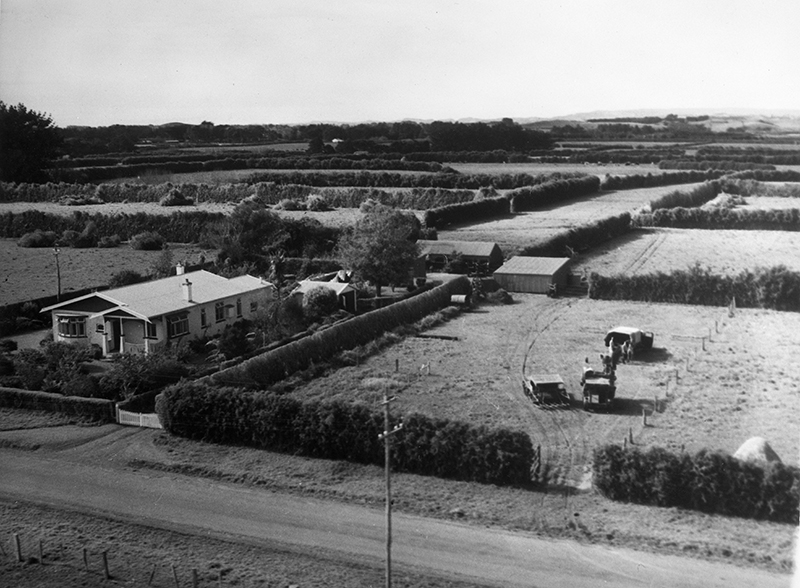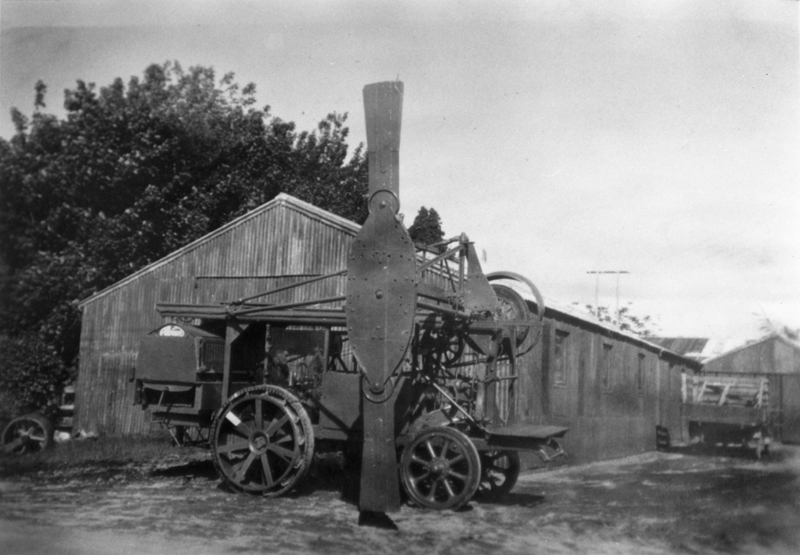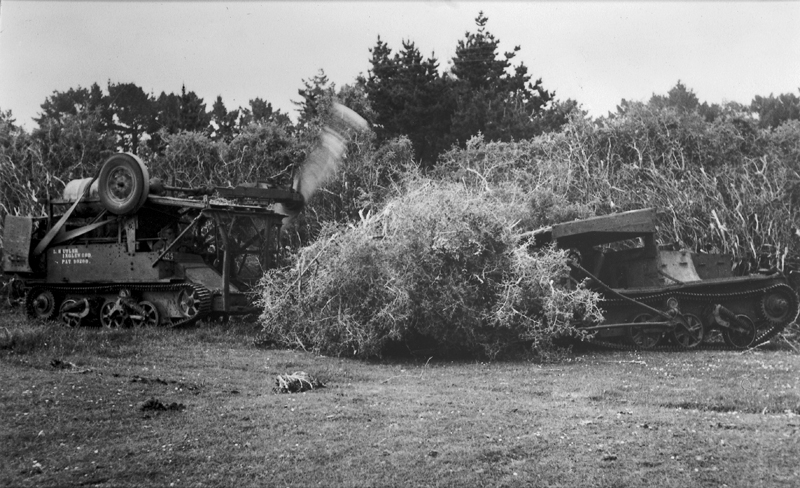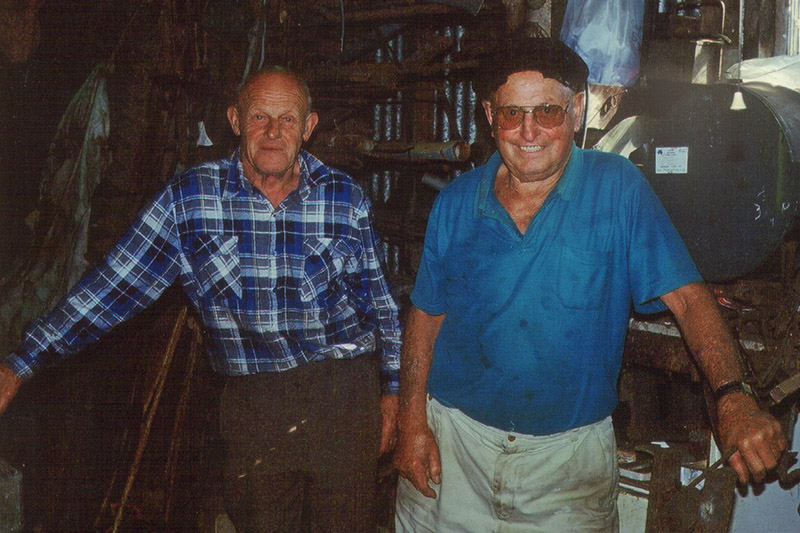





When inventor Lou Butler had an idea, he used to sketch it with chalk on the concrete floor of his Inglewood workshop. And when he was thinking, the Swiss-born farmer would sit in the sepia gloom of his enormous engineering shed and smoke cigar after cigar. Then he would swallow the butts, the same way he would shrug off doubts.
His sons, Owen and Lou Junior, say their late father used to become fixated on a labour-saving idea and wouldn't stop until he had solved it. "You start on something and you keep your nose at it until you finish the damn thing" Lou Junior imparts his namesake's philosophy. This led his dad to come up with a power of inventions, including a sheep sling, articulated trailer, turf cutter, trench digger, butter box press and his two most famous, the auto hay sweep and the boxthorn hedge cutter.
Lou Butler Senior, who we will call ‘Butler’ to prevent confusion, was born in Aargau, Switzerland on 25 March 1893. Nine years later, Butler (originally pronounced Beautler), his parents and three brothers sailed for Wellington aboard the Konigin Luise and then travelled to Inglewood.
His father, Alois Butler, set up a business making blackberry wine. "Years ago, half these farms were covered with blackberry" Owen says, telling how local people used to pick bucketsful of the tart fruit and sell them to the winemaker. Butler didn't follow his dad into the business – he filled his cup in other ways.
"He left school when he was in standard five" Owen says. Butler worked as a surveyor, travelling round the central North Island by horse, an animal he grew to love. Lou says he even worked with the wild ones. "He used to break in horses before he started all this" he says, standing beside a hedge cutter. Later, Butler bred outstanding racehorses, and laid a mile track on his Inglewood farm.
He even met his wife through horses. During his surveying days, he used to pick up mounts from livery stables owned by Ernest and Emma Julian. He married their daughter, Mavis, in Inglewood on 15 July 1920.
He built their home on Windsor Road, then went on to making concrete houses for the Inglewood County Council and even became a self-taught bridge builder. "One of the first bridges he built was at Kaponga. The clerk of works came to see him and said 'How is this bridge made?'" Lou grins at his dad's answer. "He said 'It's the first one I've ever built' and the clerk of works said 'Well, it's the first one I've ever seen'."
Owen says Butler's bridges were the first to have their abutments painted white. His father was building five concrete houses for the county at the same time, and he had paint to use up. The officials came to look at the completed bridge and were impressed with the finishing touches, especially as they made the structure highly visible to traffic. "They thought it was such a good idea; that's why they started being painted white" Owen says.
That was in the late 1920s – about the same time Butler was working on his auto hay sweep invention, one attached to the front of an automobile. Lou says his dad had the worldwide patent on that piece of equipment. "It was the first auto sweep – it was all drawn by horses up to then."
In the 1930s, an advertisement appeared in the Inglewood Times, saying: “The Butler ‘Auto Sweep’ – patented and manufactured in New Zealand – is built entirely of steel and hardwood, easily attachable to car, lorry or tractor.” Butler's invention, patent No 59912, had a major advantage – it could go backwards, which a horse can't do.
It was also fast. Owen and Lou loved to watch their dad dazzle the doubters. "They'd say, we can stack more than you can shift'," Owen says. Butler would then sweep so much together that the mound would fall down before the stackers were able to move it.
The first demonstration he gave was to a group of sceptical Inglewood farmers in the process of building a stack. They saw the original auto sweep on the front of Butler's car and snorted with derision. To them, the six-foot-wide sweep looked like a toy rake. But after a few hours they were pleading Butler to stop. The men couldn't keep up with the auto sweep, which could rake 1.4 acres (.56 hectares) of silage or 3 acres (1.2 hectares) of hay an hour.
After perfecting the invention, Butler travelled overseas to arrange the manufacture of his auto sweep. He went to Australia in 1928 and again in 1931, the same year he went to the United States. Lou and Owen say most of the auto sweeps sold on the New Zealand market were made in the Miro Street workshop. Between 1928 and 1943, about 200 were turned out each year. In all, about 2500 were made in Inglewood, but the family has no records of how many were made overseas. "There are still a few around" Owen says.
But its popularity plummeted from 1942, when the mobile hay baler overtook the basic sweep. By the mid-1950s, the Butler Auto Sweep was history.
In the meantime, its ingenious creator had been working on other apparatus, including the turf cutter. This involved a sharp U-shaped blade attached to the front of a Ferguson 19 tractor. "Years ago, if you had to do a retaining wall, you used to use turf" Owen says.
In the early 1940s, his dad developed a machine that cut long channels of turf, which were 16 inches wide by 3 inches deep. These were then hand cut by a custom-designed slicer, not unlike a large biscuit cutter. After being chopped down to size, these one-foot-long blocks turf were used to make the retaining walls. Owen explains how the slabs were turned upside-down, so the grass would grow through the dirt and into the next block. This ensured strength and a natural way of binding the wall.
And there were other farming improvements.
"The sheep sling" states Lou, pointing at a picture of a contraption that looks frighteningly like human birthing stirrups. But this is definitely made for animals, with the two, chain-held slings placed around the ewe's body to hold her up.
A lot of those old ewes got cast [when they were pregnant]" Lou says. "He made that so they could get the circulation back in their feet." He says the sling was also used to help orphan lambs, often rejected by strange ewes. "They [the ewes] were put in that and they couldn't run away and the lamb was able to suckle."
Owen says his father was always trying to solve problems. "People used to come and see him and say 'Lou can you make us something?' Us boys had to do all the work while he did all the inventing."
Butler was never idle. "Work came first, second and last," Owen says. Often that workshop floor was a crazy mess of chalk marks, which eventually evolved into a recognisable piece of machinery. "His idea was that you didn't make it bulky, you made it simple so anyone could handle it. That was his idea on anything."
One of Butler's solo brainstorming sessions led to more comfortable journeys for his racehorses.
Lou says his father was concerned about the horses being bounced around while being transported to and from racetracks. "He made one of the first articulated trucks" Lou says. This enabled the horse-float trailer to turn right angles, enabling Butler to get out of tight spots.
Which is what he had to do when dealing with transport authorities back in 1928. "They couldn't register it as a trailer," Owen says. "And not as a truck because it [the trailer] was behind the truck. They had a hell of a trouble … they came up with an articulated trailer. It was the first in the world – as far as I can remember. He didn't patent that one."
Often Butler was too busy getting on with his next invention to be concerned with bureaucracy. This cost him dearly with one of his most practical machines – the trench digger. In 1939, he built the machine to dig cable trenches for a radar station at Tikorangi. "That was the first chain digger – this is where it all began" says Owen, looking around him. "They are exactly the same as what they use today."
The digger was so ground-breaking it generated a huge amount of interest. "He had all the professors from Wellington university, MPs from Parliament came up and looked at it. They were that impressed with it they wanted to take the design of the teeth that he had on the chain" Owen says.
The brother’s debate whether their father allowed one of the teeth to be taken back to Wellington – they agree to disagree. However, they concur on the rest of the story, which Owen shares: "He had a temporary patent on it. But he had other ideas and he didn't carry on and before he had the chance to get his permanent patent, it had run out."
Not long after seeing Butler's digger, the New Zealand Government imported a machine from the United States. "Which had identical specifications to the one he had here, but they [the manufacturers] had altered it a little bit. It was hydraulic" Owen says. "Yes, he was grumpy about it."
In 1941, the Swiss got his own back.
Owen says the Home Guard decided to make use of Butler's 100-acre farm. "We couldn't stop them. They were going to guard Inglewood. They had dozens of these trenches over the farm here. They were going to make them safe by putting manuka branches over them – that turned them into deathtraps!"
Butler had fought alongside one of the Home Guard commanders during World War One, so rang him to complain. The old mate told him he could do what was needed to make the trenches safe. That's how the inventor came to develop the tip truck. He took the back off a truck and put on a moveable trailer and attached a chain to it. "As he drove over the chain, it tipped the whole body up" Owen says.
The boys dug up dirt, piled it on the trailer and their father backed the truck up to the trenches and tipped in the dirt. "There was hell to pay, the next time the Home Guard came to practice. They were going to prosecute him, do all sorts of things. When the colonel came to have a look at them, he said 'By God Lou, you made them safe'."
While he could keep his family from danger at home, his reach didn't extend overseas. On 18 October 1944, the eldest of his 10 children, Iden Alois John Butler, was killed during flight training in New Caledonia. "He got into a spin and couldn't get out of it" says Owen. Iden had been a pilot in the New Zealand Air Force.
His grieving father didn't stop inventing, and in 1945, Butler developed the butter box press. "That was when cardboard came in" Owen says. In the depths of the Miro Street workshop, which is the size of a small school hall, the brothers find a rusty example still in working order. Owen clamps a cardboard husk in place and presses it into the shape of a box, explaining how the bottom was glued. Outside the shed, a long heavy blade, about the length of a small car, rests on its side. This steel propeller-like piece is from an out-of-use boxthorn hedge cutter.
The Butler brothers tell how their dad came up with the cutting plan back in 1941. "We were out at Kaupokonui building a dam for the dairy factory," Owen says. "Of course we had to go through farms there, with hedges that were damn near a chain wide [20 metres]. Dad said to the farmer, ‘God, you must have acres and acres of land covered in boxthorn hedges’." The farmer agreed, but was in a quandary over how to cut them back. In those days they were slashed by hand and horses were used to pull the thorny prunings off the hedges and into piles for burning. This took hours and hours.
"He came home and thought 'There must be a way of cutting them', so he started designing on the concrete floor" Owen says. Lou continues: "All he used was chalk, so he didn't have to throw away a piece of paper."
The first cutting-hedge design was assembled on a 1928 Fordson tractor. The single-shafted three-metre blade was mounted on the top-side of the vehicle and was driven by a Dodge motor. Test runs on hedges near the workshop were a roaring success, but Taranaki farmers weren't so easy to convince. Many feared their boxthorn barriers wouldn't survive their military haircuts – short back and sides – so Butler had to give guarantees to cautious clients.
They did endure, and so did the military theme. Model No 3 (cutters 3 and 4) involved a Bren-gun carrier mounted on a truck. "Every time they had army sales, they would send us pamphlets. One time we went to Wellington we brought 10 Bren-gun carriers" Owen says. These were loaded on a train, one carrier per wagon, and hauled to Inglewood, where they were driven off in convoy. "Half Inglewood was out watching us. That was in about '54."
Today, around half a century later, hedge cutters No 5 and 6 (Model No 4) are still going strong – along with their drivers. Butler died of cancer in 1964, leaving his legacy of inventions. The remaining two brother’s stand beside the fifth monster machine, its wicked, 3.6 metre blade standing upright at the back. "That was an army dump truck. We shortened it by about a foot to give you sharper turning" Owen says. "Everything's built on that." The driver's area is surrounded by a grid of steel to protect the operator during the blade-belting battle against boxthorn and barberry.
"We've never been hurt by anything coming through" says Owen, then he rethinks. He pulls up his sleeve to show a war wound. In 1965, he was whirring through a hedge at Pungarehu when the blade hit a boulder. A tiny shard of steel sheared off and hit him in the upper left arm. "I put my fingers in to grab it out and I burnt these two" he says making a pincer with thumb and pointer. "It was like a flint. It was more or less red hot. The [melted] fat was running down my arm." Lou adds: "It was years before the hole closed up."
The men still enjoy powering up the machines and slashing hedges. "It's good to get it out and get started" Owen says. "But after about two hours you think 'What the hell are you doing this for?'"
The Butler Brothers business used to cover all parts of Taranaki and even Whanganui, but now they stick to north Taranaki and Opunake. Modern mulching machines have slowly edged them out of the market, but there are still a few farmers keen to see the old monsters in action. "I was going to retire at the change of the century" Owen admits.
But when the call of the wild comes, the Butlers answer. "It's touch and go which will wear out first – the machines or us" he grins.
Please do not reproduce these images without permission from Puke Ariki.
Contact us for more information or you can order images online here.